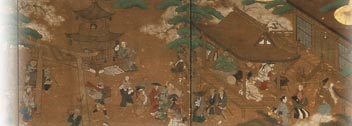Performance: “Mittsu no uta de dodontoka” Symposium: “The Meaning of Performance Arts for Everyone”
Outline
| date | Sunday, May 11, 2008 |
|---|---|
| Venue | Ono auditorium, Waseda University |
| Organizer | Artistic and Cultural Environment Studies Course |
| outline | Performance: “Mittsu no uta de dodontoka” Symposium: “The Meaning of Performance Arts for Everyone” |
Details
The “Able Art on Stage” program, which has been in operation since 2004 with the support of civic arts movements and private-sector companies, is a theatrical activities program in which people with disabilities take part; it has created opportunities for many hidden talents to be discovered and to blossom and has opened up new possibilities for artistic expression.“Mittsu no uta de dodontoka (Three songs parampapumpum)”, the participation project for 2007, is a performance piece on the themes of “family”, “work”, and “sex” which composer TSURUMI Sachiyo and choreographer YAMADA Tamami developed during a series of music and dance workshops with people with learning disabilities. The Artistic and Cultural Environment Studies Course with the support of various related sections arranged for a performance to be given on the Waseda campus and simultaneously held a symposium to consider the democratization of the process by which arts are produced and received in society. This event also provided an opportunity to explore within the context of cultural policy studies how new theatre arts activities can be implemented. More than 100 people attended.
At the symposium, which was chaired by Professor TAKEMOTO Mikio, program leader and Executive Director of the Theatre Museum, Mr. HARIMA Yasuo (Executive Director of Able Art Japan) gave the keynote address, which was entitled “Report from ‘Able Art on Stage’: Art for Living”; then Ms YAMADA Tamami (choreographer and member of the “Mittsu no uta” project executive committee) and Mr. ITO Yasuo (professor, Faculty of Art and Design, Toyama University, and a guest lecturer in the Waseda University Theatre Museum GCOE Artistic and Cultural Environment Studies Course) commented from their respective positions.
In his keynote address, Mr. HARIMA discussed the history and social background of the Able Art movement: how the question “Why are art and culture important for personal well-being?" – a question which he has often been asked during the thirty-five years that he has been involved in artistic activities for people with disabilities – succeeded in evolving first in the areas of the fine arts and music into the Able Art movement, which regards these activities by the disabled as “able art”, and then developed further into the “Able Art on Stage” project and the “socialization of theatrical wisdom”. The encounter with the theatrical arts liberates the five senses of the participants, deepens their understanding of themselves and others and increases their communication skills. In the case of these activities, an important task has been to redefine the concept of art itself in order to make it something that all people can experience in relation to themselves.
Next, Ms YAMADA gave a vivid account of three points: the production process, the appealing qualities of people with mental disabilities and the experiences derived from the interchange between the participants and an original art work. This talk allowed the symposium participants, who had just experienced the work as an audience, to share directly in the creative process and clearly showed the role that artists play in the process of change that occurs in participants involved in the creation of a work for the stage.
From the standpoint of cultural policy studies, Mr. ITO pointed to aspects of the “able art” concept that have something in common with trends in public cultural policies abroad and introduced “art for all” in Germany in the 1970s as a case in point. At that time a concept of cultural policy emerged in which culture, redefined to include the various cultures that exist in everyday life, was restored to the community with the aim of creating a society in which all people can have contact with art and culture in a form relevant to themselves. This idea had an impact on the subsequent social system. Mr. ITO also alluded to the fact that artists are able to become the media or agents for liberating the repressed feelings of people with diverse sensibilities, and he discussed the importance of devising ways to develop these abilities and make the most of them on an on-going basis.
The point was made in the symposium that Able Art is a concept that applies to all people who live in modern society, not just to those with disabilities. In drafting cultural policies at the public policy level, it is important to examine the concept of culture and to undertake a fundamental reassessment of the implications of the existing system for the arts and culture that society has created over time. The Artistic and Cultural Environment Studies Course will continue to study various aspects of the cultural policies and systems that support the arts and culture in Japan and other countries.


